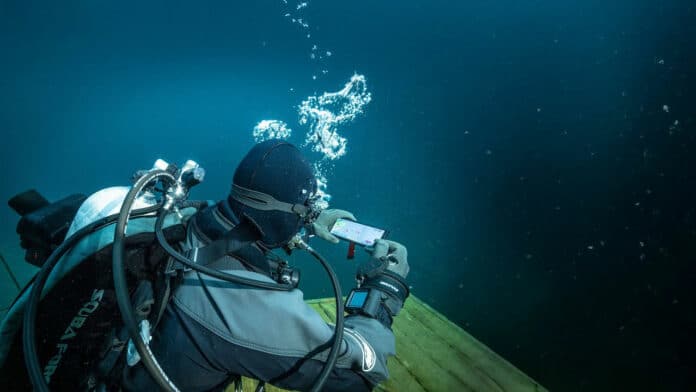German underwater tech company EvoLogics has developed a new Diver Navigation System (DNS) that helps divers track their position underwater in real time. Since GPS doesn’t work underwater, the DNS uses floating and wearable acoustic transponders to overcome this problem.
The system consists of three main components: a tracker unit, a diver console, and a USBL (ultra-short baseline) buoy. A buoy helps track a diver’s position in the water. It emits acoustic signals that are picked up by a tracker unit mounted on the diver’s air tank. The tracker unit responds to these signals, and the time between the initial ping and the reply ping determines the diver’s position relative to the buoy.
EvoLogics aimed to streamline complex underwater tasks such as search and rescue, salvage operations, recovery efforts, and cleanup operations. The Diver Navigation system does this by enhancing coordination, improving task management, and fostering efficient information sharing. Ultimately, the Diver Navigation system increases the effectiveness of diver operations.
The battery-powered diver unit is designed to be compatible with all EvoLogics 18/34 modems and USBL systems. It also comes with mounts that allow it to be attached to the diver’s scuba tank or most common underwater scooters. The tracker’s molded unibody design ensures that it is compatible with various diving equipment and makes installation straightforward.
The diver console is a useful tool for divers, as it helps them stay connected to the rest of the team. It’s a small device that fits on the wrist and connects to the modem tracker via cable. Using the SiNAPS user interface, divers can view the map of the operations area, see the locations of other divers and the support vessel, and communicate with other team members using the text chat tool.
On the surface, the USBL buoy plays an important role in the operations. It acts as the acoustic node and is equipped with a USBL antenna, an integrated PC with SiNAPS positioning software, a dual-antenna GNSS receiver, and a WiFi access point. The buoy is designed for mobile scenarios, which makes it easy to set up and ensures reliable bidirectional diver tracking and message exchange.
Divers can also check the locations of other divers in their group thanks to a buoy that can communicate with up to five trackers at a time. The buoy even uses an onboard WiFi transceiver to relay its data to a topside support crew, who can track the locations of all the divers on a laptop or tablet.
The system boasts impressive numbers, with an underwater communications range of 1.5 km (0.9 miles), a positional accuracy of plus or minus 10 cm (3.9 in), and a claimed battery runtime of up to eight hours. The tracker and console have a maximum depth rating of 50 m (164 ft).
